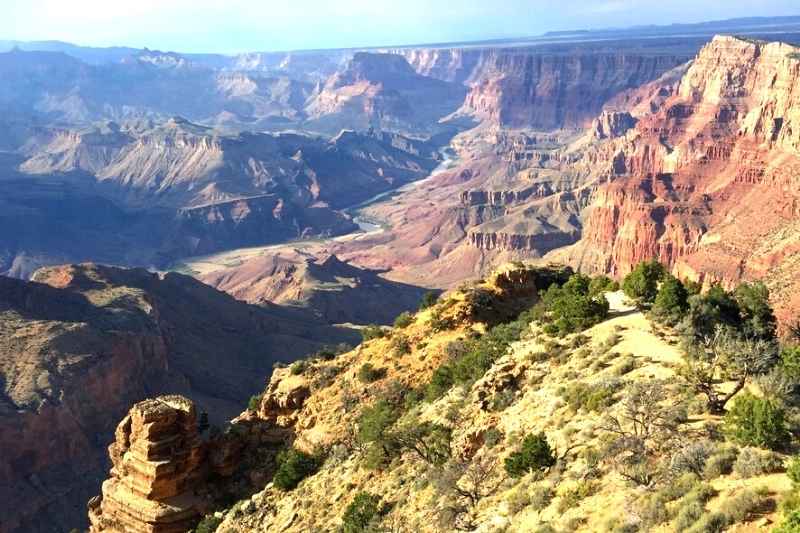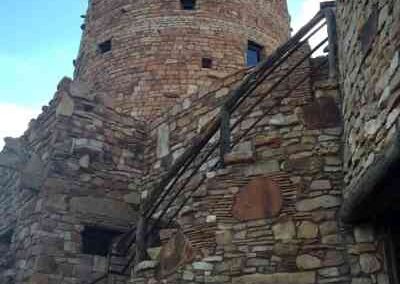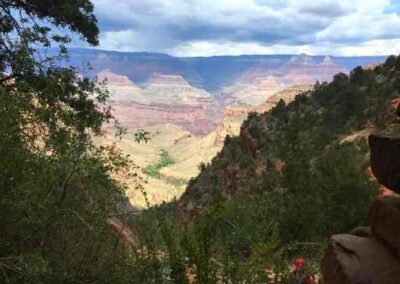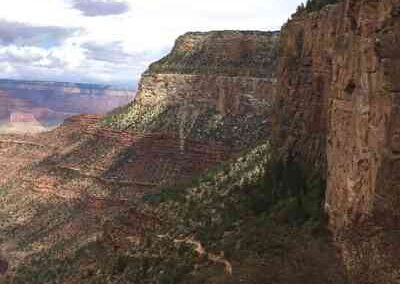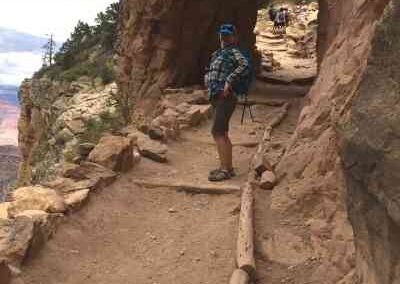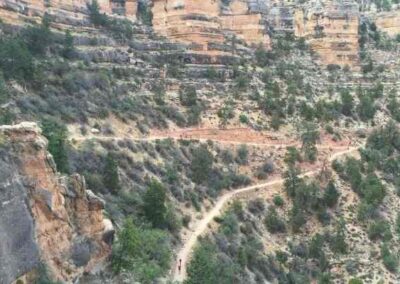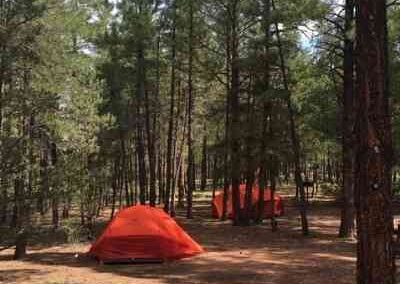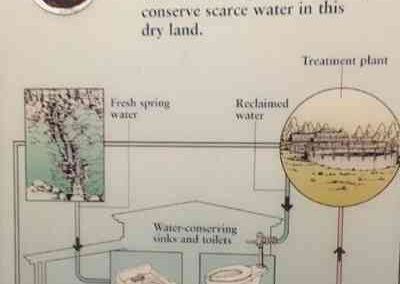The Grand Canyon is one of the most powerful and inspiring landscapes in the United States.
It’s no wonder the Grand Canyon is one of the seven natural wonders of the world. It truly overwhelms the senses the first time you see its geologic beauty.
As the famous naturalist John Muir wrote: “In the supreme flaming glory of sunset the whole canyon is transfigured as if the life and light of centuries of sunshine stored up in the rocks were now being poured forth as from one glorious fountain, flooding both earth and sky.”
Visiting the Grand Canyon? Check out Yvonne’s tips for getting the most out of your visit.
Arriving to Grand Canyon National Park:
There are two rims in the Grand Canyon: the South Rim and the North Rim. The South Rim is the most popular entrance to the national park. To make getting around the South Rim easier, park your vehicle in any parking area and use the free shuttle bus system to visit the visitor center, lodges, restaurants, gift shops, overlooks, and trailheads. Buses run at frequent intervals from sunrise to sunset. The park’s newspaper, The Guide, will detail bus route maps and schedules.
Start your adventure at the Grand Canyon Visitor’s Center:
Be prepared to spend a decent amount of time at the Grand Canyon Visitor’s Center. It’s truly fascinating! Be sure to pick up a passport book to record your visits to our national parks. With the passport book, you can collect stamps, stickers, and take notes to remember your visit.
The Guide also includes a list of available food and lodging. Be aware that some lodging may require reservations up to 13 months in advance, such as camp sites and the Phantom Ranch. The Phantom Ranch is accessible only by foot or mule on the Bright Angel Trail leading to the canyon floor. You can purchase food at restaurants near the visitor center (which can be expensive) or you can bring your own food and picnic in a permitted area.
Things to do and places to see:
- Watch the sunrise/sunset at Mather’s Point.
- Yavapai Point – Geology Museum, the geology of the canyon
- Tusayan Museum – Highlights Native American cultures
- Attend a park ranger program. We attended the Starry, Starry Night program and learned how the constellation rotated around Polaris and recognized constellations in different seasons of the year.
- Visit the Desert View Watchtower – View the pictographs and petroglyphs representing the natural world, stars, and animals created by Native Americans designed by architect Mary Coulter*.
- Stop by the Verkamp’s Visitor Center
- El Tovar Hotel – Considered the crown jewel of Historic National Park Lodges.
- Bright Angel Lodge – Re-created by Architect Mary Coulter*.
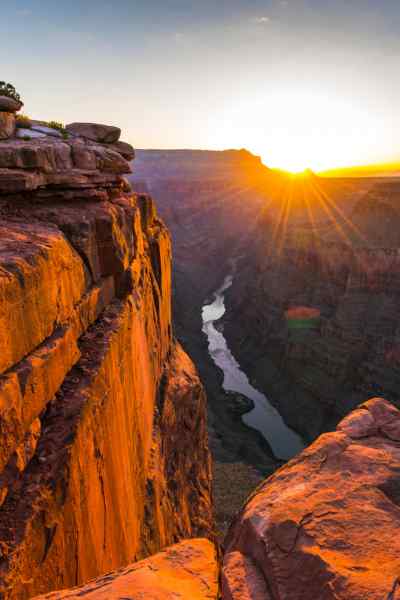
- 1 1/2 Mile Resthouse Trail – Just over 1,100 feet (335 m) below Grand Canyon’s rim; this first rest area offers visitors a taste of the struggles and rewards of the Grand Canyon’s steep trails. For most visitors, the 3-mile (4.8 km) round-trip hike from the South Rim requires a 2-4 hour commitment depending on health, hiking ability, and rest stops.
- Kolb Studio – The home, photography studio, tollgate, and business of two adventurous brothers, Ellsworth and Emery Kolb. Their photography is fantastic!
- Hermits Rest – Designed by Mary Coulter, built-in 1914, located at the western end of Hermit Road at the South Rim.
- Lookout Studio – Ancient ruin re-created by Mary Colter.
- Mary Colter’s Hopi House – Mary Colter (1905) recreated the Hopi House as a model after the 1,000-year-old pueblo dwellings of the Hopi village in Old Oraibi, paying homage to the early inhabitants.
- Grand Canyon Train Depot
- Mule Trips, Rafting Trips, and other tours should be reserved well before visiting the Grand Canyon.
- Locate a spot to sit quietly and use your senses to take in what you see, hear, smell, touch, and taste. It is simply breathtaking! Observe the canyon’s remarkable features; the forest, desert, plants, animals, and river habitats are incredible. Plants and animals turned into rock formations show us how climate change altered ecosystems throughout time. This time spent may inspire you to get involved in helping to conserve, preserve, and protect our parks, whether they are national, state, or local to your home.
* To learn more about architect Mary Colter, pick up the book Mary Colter, Builder Upon The Red Earth at any of the Grand Canyon’s bookstores and gift shops. It is a fascinating story!
Safety is very important!
At the Grand Canyon and any national park, it’s important to enjoy your visit safely. Here are some tips to ensure your experience is memorable in the best ways:
- Stay on the trails and away from cliffs.
- Thunderstorms are common in the summer. Seek shelter and stay away from the rim and exposed areas when lightning threatens.
- Pets must be leashed. Pets are permitted in developed areas about the rim but not on shuttle buses.
- All vehicles, including mountain bikes, are restricted to maintained roads.
- When hiking, carry food and water. Wear sun protection and appropriate clothes, including sunglasses and a hat, and footwear with an excellent grip.
- Hiking to the Colorado River and back in one day is highly discouraged. Instead, try one of the many hikes that are shorter in distance. I recommend the 1 1/2 Resthouse Trail.
- Feeding deer, squirrels or other animals is illegal.
Enjoy your experience and share your photos with us on Instagram @one_planet_life.
Yvonne’s Grand Canyon National Park Photo Gallery
Check out Yvonne’s Insider Tips for exploring these other national parks:

Written by Yvonne Dwyer
Master Naturalist and OPL Content Contributor
“It is truly an honor for me to be a contributor to One Planet Life. By sharing my experiences and lifetime of learning, I hope to inspire conservation, sustainability, stewardship, and awareness of enjoying the natural wonders of the world for the wellbeing of people and the planet.”

